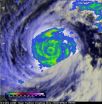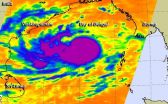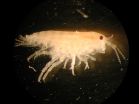NASA gathering data on Super Typhoon Vongfong as Japan prepares
2014-10-10
(Press-News.org) Super Typhoon Vongfong continued on its trek north through the Philippine Sea while slightly weakening on Oct. 10. NASA's TRMM and Aqua satellites provided forecasters with cloud extent, rainfall rates and distribution and more.
Vongfong was a super typhoon with wind maximum sustained winds of 145 knots (167 mph) when the TRMM satellite flew over on October 8, 2014 at 2328 UTC 7:28 p.m. EDT). TRMM's Microwave Imager showed that Vongfong was producing rainfall over a large area and heavy rainfall in the eye wall (the powerful thunderstorms around the open eye) and in multiple bands of thunderstorms wrapping into the center. On Oct. 8, Vongfong was the most powerful typhoon since super typhoon Haiyan that killed over 6,000 people after hitting the Philippines in November 2013.
On Oct. 10 at 2:05 UTC, the Moderate Resolution Imaging Spectroradiometer or MODIS instrument aboard NASA's Terra satellite captured an image of Typhoon Vongfong in the Philippine Sea. The visible image showed that the eye had become filled with high clouds, although it maintained its symmetrical circular shape. Feeder bands of thunderstorms wrapping into the center from the north, extended over Japan's Ryukyu Islands.
On Friday, Oct. 10 at 1500 UTC (11 a.m. EDT) Typhoon Vongfong's maximum sustained winds had dropped slightly to 115 knots (132 mph/213 kph). Forecasters at the Joint Typhoon Warning Center expect winds to drop to 105 knots (120.8 mph/194.5 kph) by Oct. 11 at 1500 UTC, and 85 knots (97.8 mph/157.4 kph), by Sunday, Oct. 12 at 1500 UTC (11 a.m. EDT).
On Oct. 10 at 11 a.m. EDT Vongfong was centered near 23.5 north and 129.2 east, about 220 nautical miles (253 miles/407 km) south-southeast of Kadena Air Base, Okinawa, Japan. Vongfong was moving to the north at 8 knots (9.2 mph/14.8 kph) and generating 38-foot (11.5 meter) high seas. On Oct. 8 when Vongfong was a Category 5 typhoon, it was generating wave heights to 50 feet (15.2 meters).
Vongfong continues to slowly weaken while moving north. The Joint Typhoon Warning Center expects Vongfong's center to pass just east of Okinawa on Saturday, Oct. 11, before turning to the northeast and changing to an extra-tropical cyclone over Japan.
INFORMATION:
Rob Gutro / Hal Pierce
NASA's Goddard Space Flight Center
[Attachments] See images for this press release:


ELSE PRESS RELEASES FROM THIS DATE:
2014-10-10
DURHAM, N.C. –- No single "one-size-fits-all" model can explain how biodiversity hotspots come to be, finds a study of more than 700 species of reptiles and amphibians on the African island of Madagascar.
By analyzing the geographic distribution of Madagascar's lizards, snakes, frogs and tortoises, an international team of researchers has found that each group responded differently to environmental fluctuations on the island over time.
The results are important because they suggest that climate change and land use in Madagascar will have varying effects on different ...
2014-10-10
NASA's Aqua satellite passed over Tropical Cyclone Hudhud on Oct. 10 as it reached hurricane-force.
The Atmospheric Infrared Sounder or AIRS instrument that flies aboard NASA's Aqua satellite read temperatures of thunderstorm cloudtops that make up Tropical Cyclone Hudhud when it passed overhead on Oct. 9 at 19:53 UTC (3:53 p.m. EDT). The data showed the coldest cloud top temperatures were in thunderstorms circling a developing eye. Cloud top temperatures were as cold as -63F/-53C, which have the potential for dropping heavy rainfall.
Hudhud's maximum sustained winds ...
2014-10-10
Small cues that display a user's transaction history may help a website feel almost as interactive as chatting with an online customer service agent, paving the way for more cost-effective websites, according to researchers.
"One of the challenges with online interactivity is trying to imbue the site with a sense of contingency -- the back-and-forth feel of a real conversation," said S. Shyam Sundar, Distinguished Professor of Communications and co-director of the Media Effects Research Laboratory. "What we found is that providing some information about a user's interaction ...
2014-10-10
A new study led by a Canadian marine zoologist reviews the world list of specialist driftwood talitrids, which so far comprises a total of 7 representatives, including two newly described species. These tiny animals with peculiar habits all live in and feed on decomposing marine driftwood. Dispersed across distant oceanic islands they use floating driftwood to hitch a ride to their destination. The study was published in the open access journal Zoosystematics and Evolution.
Tourists are familiar with talitrids as sandhoppers, found in burrows on sand beaches, or shorehoppers, ...
2014-10-10
New clinical research from UC San Francisco shows that 341 HIV-infected men who reported using stimulants such as methamphetamine or cocaine derived life-saving benefits from being on antiretroviral therapy that were comparable to those of HIV-infected men who do not use stimulants.
That said, those who reported using stimulants at more than half of at least two study visits did have modestly increased chances of progressing to AIDS or dying after starting antiretroviral therapy compared to non-users. The data was collected between 1996 and 2012.
"Patients with HIV ...
2014-10-10
PHILADELPHIA –The pneumococcal vaccine recommended for young children not only prevents illness and death, but also has dramatically reduced severe antibiotic-resistant infections, suggests nationwide research being presented at IDWeek 2014™. Pneumococcal infection – which can cause everything from ear infections to pneumonia and meningitis – is the most common vaccine-preventable bacterial cause of death.
The 13-valent pneumococcal conjugate vaccine (PCV13), first available in 2010 (replacing 7-valent pneumococcal conjugate vaccine, PCV7), reduced the ...
2014-10-10
PHILADELPHIA – Old-school face-to-face social networking is a more effective way to identify people with HIV than the traditional referral method, suggests research being presented at IDWeek 2014™. The study shows that social networking strategies (SNS) – enlisting people in high-risk groups to recruit their peers to get tested – is more efficient and targeted than traditional testing and referral programs, resulting in 2-1/2 times more positive test results.
As many as 20 percent of HIV-positive people are unaware of being infected with the virus, ...
2014-10-10
The experiments were carried out on endofullerenes, molecules of C60 into which smaller molecules of Hydrogen (H2) had been inserted. The results, published in Physical Review Letters, represent the first known example of a quantum selection rule found in a molecule.
Similar techniques were also used by the same team to uncover an exciting new symmetry-breaking interaction of water molecules with C60 cages, published last month in Physical Chemistry Chemical Physics.
The use of fullerenes such as C60 to trap smaller molecules, using cutting-edge molecular surgery techniques, ...
2014-10-10
This news release is available in German.
The distance between the Earth and the Sun has no influence on the decay rate of radioactive chlorine. You could ask: "And why should it anyway?", because it is well known that the decay of radionuclides is as reliable as a Swiss clock. Recently, US-American scientists, however, attracted attention when they postulated that the decay rate depends on the flow of solar neutrinos and, thus, also on the distance from the Earth to the Sun. Their assumption was based, among other things, on older measurement data of the Physikalisch-Technische ...
2014-10-10
WASHINGTON, DC – OCTOBER 10, 2014 - Mineral coatings on sand particles actually encourage microbial activity in the rapid sand filters that are used to treat groundwater for drinking, according to a paper published ahead of print in Applied and Environmental Microbiology. These findings resoundingly refute, for the first time, the conventional wisdom that the mineral deposits interfere with microbial colonization of the sand particles.
"We find an overwhelmingly positive effect of mineral deposits on microbial activity and density," says corresponding author Barth ...
LAST 30 PRESS RELEASES:
[Press-News.org] NASA gathering data on Super Typhoon Vongfong as Japan prepares





